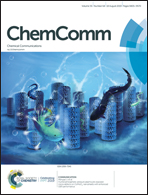Chiral footprint of the ligand layer in the all-alkynyl-protected gold nanocluster Au144(CCPhF)60†
Abstract
The electronic structure and chiroptical properties of the recently isolated and structurally characterized all-alkynyl-protected gold nanocluster Au144(CCPhF)60 were analyzed via density functional theory (DFT) computations and compared to those of the structurally similar all-thiolate-protected Au144(SCH2Ph)60. While DFT predicts very strong CD signals of similar strength for both clusters, the origins of chiroptical activity are markedly different. The chiral response of Au144(CCPhF)60 originates only from the footprint of the outermost gold-ligand layer of 30 FPhCC-Au-CCPhF units covering an achiral Ih-symmetric Au114 core whereas the Au114 core of the Au144(SCH2Ph)60 cluster has a chiral I symmetry and it alone produces CD signals that are comparable to those of the well-studied chiral Au38(SR)24. These signals are then amplified by a chiral arrangement of the protecting 30 PhH2CS-Au-SCH2Ph units. These results shed light on the origins of chiroptical activity of ligand-protected gold clusters that form an important class of atom-precise nanomaterials with potential applications in chiral sensing and enantioselective catalysis.



 Please wait while we load your content...
Please wait while we load your content...